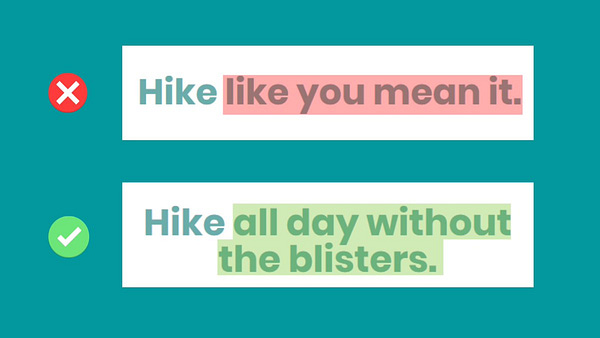
How great marketing “upgrades” people
At the heart of it, marketing is about telling stories of what a product does for customers.
How can it help them be more productive, connected, or entertained?
Great marketing helps people envision who they could be, what they could do, and where they could go.

As marketers, we often get caught up with how sexy, exciting, and cutting-edge our products are.
People don’t buy products. They buy better versions of themselves.
In her book Badass: Make Users Awesome (what a great title, right?!?), Kathy Sierra explains:
“Upgrade your user, not your product. Don’t build better cameras – build better photographers.”
What does that even mean?
Let me share the three ways that products upgrade people.
🏆 3 ways that products upgrade people
In the Jobs-to-be-Done theory, people “hire” products for three interconnected reasons: functional, emotional, and social.
Understanding and using these for your marketing is a potent power-up.
1. Functional upgrade 🛠
Products give people new abilities and superpowers that they couldn’t do before.
Samuel Hulick visualizes this using Super Mario. When Mario touches a flower power-up, he can hurl fireballs at his enemies!

Great marketing empathizes with people’s current struggles and paints a vivid picture of a better world with the product. The better you can do that, the more likely people are to try out the product and become customers!
AbstractOps, a platform that allows you to create and sign legal documents, does an excellent job of doing that.

Rather than having to deal with a back office that feels like a tornado, AbstractOps makes it easy to create, sign and file all your contracts
What can your customers do now with your product that they couldn’t do without it?
2. Emotional upgrade ❤️
The second way that products upgrade people is by helping them feel or avoid feeling things.
It could help them feel confident with a new strategy or direction.
Or it could be to remove the frustration of doing tedious tasks.
Walt Disney, the creator of Mickey Mouse, said that The Disney Company’s goal is to “create happiness,” and they do this “by providing the best in entertainment for people of all ages everywhere.”
You don’t even have to call out the emotion like Disney.
You can visualize it with descriptive words (e.g., “Hike all day without the blisters.”)

Jeremy Moser @jmoserrCopywriting tip: focus your marketing on pain points people will visualize. Avoid broad statements that lack emotion:

583Likes49Retweets
Can you feel the pain of having blisters from hiking day? Describing scenarios that evoke emotions is a great way to motivate people to act.
How do you want customers to feel or avoid feeling after using your product?
3. Social upgrade 👩💼
The third way that products upgrade people is socially.
When we invest time and effort into a product, we do so in a social context, whether at home with family or work with colleagues.
As per Maslow’s hierarchy of needs, once we have the basic needs, we look for additional ways to feel loved, connected, and accomplished by others.
Take, for instance, one of Canva’s Facebook ads.

This ad makes Canva’s social upgrade obvious: it’s to help create professional designs that your boss and co-workers will notice, even with zero design training or experience!
You might hear them say, “Wow! This design is beautiful. I didn’t know you were so creative. Good job!”
For your product, how does it impact how others perceive your customers?
Are they seen as more knowledgeable? Do you make them look more professional? Do you help them become the hero in their workplace?
🛫 Crossing the chasm (plus a free resource)
When I visited the Grand Canyon many years ago, I remember looking over the ledge and feeling deathly afraid.
Imagine if I had to cross over it on a flimsy, untested bridge.
Hell, naw!
Change often feels like that.
Our job as marketers is to help people feel safe and secure, so they cross the chasm to a better world with your product.
Vividly describe the product's functional, emotional, and social upgrade.
To help you put that into practice, I created the User Success Canvas from my book Product-Led Onboarding.
Download it. Print it. Drop it in a Google Slide. Share it with others.
It’s yours for free!

Here’s a short 3-min video on how to use it to power up your marketing.
⭐️ Mini power-ups
Fun-sized blurbs to help boost your marketing.
✨ Jay Clouse’s cold email formula: Jay used this simple cold email formula to interview folks like Seth Godin, James Clear, Codie Sanchez, and Sara Dietchy on his podcast, Creative Elements. I’ve swiped it and plan on using it to reach out to guests of my new show. You should to!
✨ B2B marketing isn't boring, you are: Adam Goyette dishes out some brutal truth. He also shares four tips to help you brainstorm creative ideas for interesting B2B marketing.
✨ How content fuels product-led experiences: I chat with Brett McGrath, VP of Marketing at The Juice, about how content is the fuel that drives the product-led growth flywheel. In a self-serve flow, content and copy replace the biz dev, sales, and customer success team.



